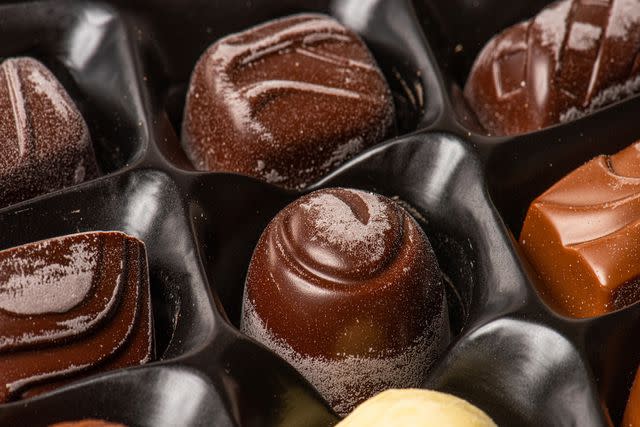What Is the Chalky White Stuff on Chocolate? And Is it Safe to Eat?
Those white spots on chocolate are the result of either fat or sugar bloom. Here’s how to avoid it.

If you’ve ever stumbled upon a long-forgotten bag of chocolate chips in the back of your cupboard or stored a box of bonbons in the refrigerator for a few days, you might have noticed a strange, chalky white residue on the surface of the chocolate. That’s the result of chocolate bloom, which is usually caused by warm temperatures or moisture. But what exactly is chocolate bloom, and how can you avoid those white spots on chocolate? Read on for everything you need to know.

What Causes Chocolate Bloom?
There are two types of chocolate bloom: fat bloom and sugar bloom. While they can both result in white or gray streaks throughout the chocolate and a chalky texture on the surface, fat bloom is typically due to heat, while sugar bloom is usually due to moisture.
Fat Bloom
Fat bloom is the most common type of chocolate bloom, and it typically happens when chocolate is not tempered correctly. Tempering is the carefully controlled process of slowly melting chocolate and then cooling it to stabilize the fat crystals in the cocoa butter, which gives chocolate a smooth, glossy shine and a firm snap. If chocolate is melted at too high of a temperature during the tempering process, the crystalline structure in the cocoa butter breaks down, which eventually leads to fat bloom.
“Chocolate is made out of sugar, cocoa and cocoa butter,” says Nathaniel Reid, a James Beard-nominated pastry chef and co-owner of Nathaniel Reid Bakery in Kirkwood, Missouri. “At room temperature, they're all solid. As we melt chocolate, the only thing that changes is the cocoa butter—it's becoming a liquid and everything else is still a solid. If you go too hot, the temper will break and the crystal structure that you want will be melted out.”
“The chocolate we buy at the store comes to us tempered, shiny, and set with a 'snap' when broken, and is the result of stable cocoa butter crystals created during the chocolate tempering process,” adds Teresa Floyd, a food writer, former pastry chef and chocolatier for Christopher Elbow Chocolates. “Fat bloom occurs when chocolate is exposed to warm temperatures. The cocoa butter in the chocolate softens, melts, and rises to the surface of the chocolate. It then re-solidifies in gray streaks known as bloom. Fat bloom is a result of fat migration from these crystals melting, then re-crystallizing into an unstabilized form in the appearance of gray streaks.”
Sugar Bloom
Sugar bloom, meanwhile, occurs when the sugar in chocolate comes in contact with moisture, which is typically a storage issue. “This happens when chocolate is stored in a humid environment or in the refrigerator where condensation will form,” Floyd says. “The moisture dissolves the sugar in the chocolate and when it evaporates, the sugar crystals re-solidify into those tell-tale spotty white dots and chalky appearance on the surface.”
Reid says sugar bloom is usually more common in milk and white chocolate because they contain more sugar than dark chocolate. “If you left some milk chocolate candies in the refrigerator, the water is going to interact with it because the sugar is hydroscopic—it likes water—and that'll create some surface sugar bloom on top,” he says.
Is it Safe to Eat?
Chocolate with fat or sugar bloom is completely safe to eat. With that said, chocolate bloom can compromise the flavor and texture of chocolate, so try to avoid it whenever possible. “It creates a chalky kind of feel to the chocolate,” Reid says. “With a tempered chocolate, you'll hear it—if you break a bar in half, it snaps. When it's not tempered, it has kind of a crumbly or very short-grained mouthfeel. It doesn't have that really pleasant melting, unctuous property that chocolate has in your mouth. It changes the mouthfeel, and also some of the aromas in chocolate are captured a little bit different.”
How to Avoid Chocolate Bloom
The best way to avoid chocolate bloom is to follow proper storage guidelines. Store chocolate in a cool, dark and dry place with low humidity. As an added layer of protection, Floyd recommends wrapping chocolate tightly in plastic wrap or in an airtight container or bag to keep moisture out. Most chocolate, including homemade bonbons and chocolate bark, does not need to be stored in the refrigerator, Reid says. But if you have a recipe such as chocolate-dipped strawberries that does require refrigeration, opt for a tightly sealed container.
To avoid chocolate bloom when making your own chocolate treats at home, make sure to properly temper your chocolate. Reid says melting chocolate on low in the microwave works just as well as a traditional bain-marie (water bath) technique, as long as you’re stirring frequently. Temperature is extremely important when tempering chocolate, so Reid recommends using a digital probe thermometer for accuracy.
Before moving forward with the rest of your recipe, check that your chocolate is tempered by dipping a metal spatula, knife, or spoon in, tapping off the excess and letting it sit on the counter for five to 10 minutes. The chocolate should look hard and shiny—if not, it’s probably not tempered. If it does harden and you see streaking or light spots, it probably has fat bloom—but Reid says not to be dismayed. “At the end of the day, the good thing about making a mistake with chocolate is if it's not tempered, you can always melt it down and try again,” he says. “If you bake a cake wrong and it's burned, well, you throw it in the trash. If your chocolate comes out untempered, you can always re-melt it and re-temper it again.”
For more Better Homes & Gardens news, make sure to sign up for our newsletter!
Read the original article on Better Homes & Gardens.

